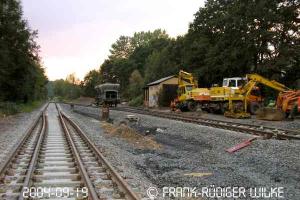These example pages ignore FRA carbody strength regulations against passenger rail, because there is no feasible option for Rogue Valley rail transit within these requirements.
Rogue River Rail Transit
Example 2: Ashland - Grants Pass
The "Ashland – Central Point" example on the last page is a standard solution. With FRA compliant trains, a reliable implementation is out of reach, but within common standards of modern passenger railroad operation, it is routine work.
This page here is different: It shows an example for Ashland – Grants Pass traffic, which would be state of the art by anybody's standard, and needs attention to every detail under any kind of regulation.
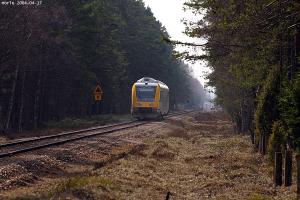
The Bombardier "Itino" is the fastest accelerating lowfloor DMU. Here an Y31 unit of Jönköpings Länstrafik AB,
Sweden.
"Ashland – Grants Pass" is more than double as long as "Ashland – Central Point". Nonetheless, desired result is "two trains, two employees, hourly traffic", despite the additional distance. As an additional delay to some of the trains, meeting freight trains can't be avoided on the longer route. Central Oregon & Pacific has its center of operations in Medford, trains pull out north and south. If Ashland – Central Point is operated hourly, freights can be dispatched into the opposite direction. But for the longer route, there must be enough schedule padding for another siding or station meet.
Settlement between Central Point and Grants Pass favours a longer stop distance in that part of the route, which helps to save time. But as well, the train sets need considerably higher performance, and need to operate at rather high cant deficiency.
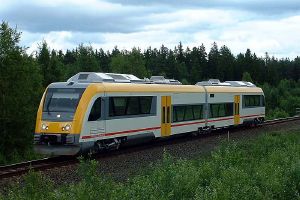
1341 hp, 76 tons, 1.8 feet boarding height – the Y31 of Jönköpings Länstrafik AB.
Needing three trains for hourly traffic would be a costly failure. It does not only require another train and another crew, but also adds considerable infrastructure costs. Passing more trains requires more switches, and switches are some of the most expensive elements of railroad infrastructure. If a faster DMU is more expensive than the example on the last page, it is still a bargain in comparison to the consequences of too slow an operation. Keeping this situation in mind, the assumptions for calculating the timetable are these:
- The track has been rebuilt, is maintained to class 5 (90 mph), is properly superelevated between Talent and Ashland and in the curvy part northwest of Gold Ray Dam.
- A waiver for operating at 5 inches of cant deficiency has been obtained.
- Where necessary, grade crossings have been upgraded to 90 mph.
- The trains accelerate to 60 mph within 35 seconds, to 90 mph within 90 seconds. (Slightly worse figures would be acceptable after curve easing work.)
- Typical station stop time: 10 - 20 seconds, needing level boarding at all stations.
The fastest lowfloor DMU in current (April 2005) production is the Bombardier Itino. This is an articulated trainset with two parts, total weight 76 tons, each part motorized with 671 hp. Motor power isn't power at the wheel, though. Air condition and auxiliaries have their own requirements. Since the full motor power can't be used anyway, Bombardier hasn't selected a hydraulic transmission for all the motor power, but a smaller gearbox, the Voith T 212 bre. Consequence is, that with any motor, the transmittable power won't exceed 2 x 617 hp. (The first Itino trains have had a lower limit, but the transmission was improved later.)
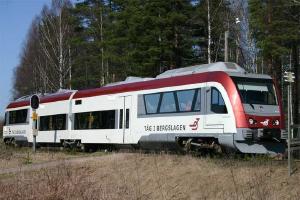
An Y31 of "Tåg i Bergslagen", Sweden. The short version of the Itino features 100 seats, accessible restroom, and
bicycle/stroller space.
Currently delivered Itino units reach their top speed of 87 mph in 112 seconds. This is a very good value for a DMU, but a questionable result for the given Rogue Valley task:
| Ashland - Grants Pass | |
|---|---|
| Line length | 44.8 miles |
| Intermediate stations (assumption) | 10 |
| Average stop distance | 4.1 miles |
| Line speed assumption | 90 mph |
| Travel time | 53 minutes |
| Average speed | 51 mph |
If the fastest offers out of serial production miss the goal by two or three minutes, these minutes are best won by minor curve easing work. Faster DMUs can be ordered, but after some calculations and phone calls, they don't appear to be the most cost-effective option in this case. Nonetheless, possibilities for buying faster DMUs rather close to serial production are collected on a separate annotation page.
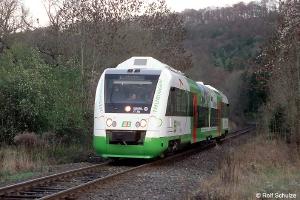
The Itino prototype, owned by Erfurter Industriebahn GmbH in Germany, was rebuilt for testing an improved transmission, which
became the current production standard.
While this page has been based on Bombardier's "Itino", Alstom could very easily rearrange its "Minuetto" DMU, currently delivered to Italy, into a train with the same size and the same performance. The Itino is currently delivered to the "Odenwald-Bahn" project in Germany, 22 units for € 3.18 million each. So there are at least two products available, for the following timetable:

